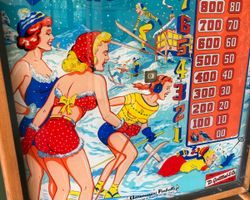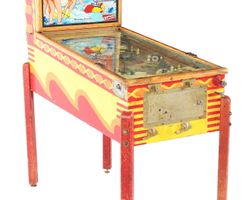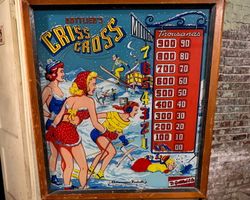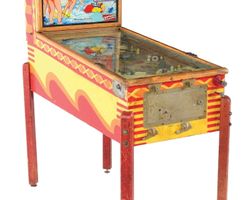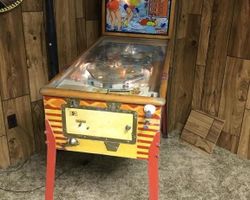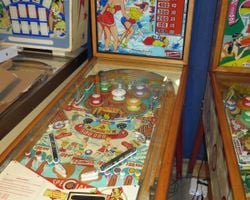Criss Cross
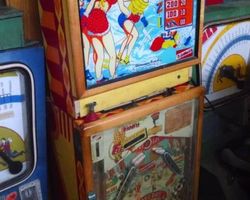
Average Prices: USD $600 to $1,300
Produced: Febuary, 1958
Production Run: 1,900 units
Machine Type: Electro-mechanical
Players: 1
Design by: Wayne Neyens
Art by: Roy Parker
The pinball machine "Criss Cross" emerged from the workshops of D. Gottlieb & Co. in February 1958, a period when electro-mechanical (EM) pinball machines were at their zenith. This single-player game, with its vibrant theme centered on winter sports and recreation, captivated players with its blend of visual appeal and engaging gameplay. Only 1,900 units of Criss Cross were produced, making it a sought-after example of Gottlieb’s mid-century innovation.
The creation of Criss Cross was largely attributed to Wayne Neyens, who was credited not only with the machine's overall design but also its concept, animation, and intricate mechanical systems. Neyens’s vision brought the snowy slopes and playful winter scenes to life. Complementing his mechanical ingenuity was the distinctive artwork of Roy Parker. Parker's artistic contributions, featuring lady skiers, cheerful snowmen, and a lively snowball fight, adorned the playfield and backglass, imbuing the machine with a bright, inviting aesthetic that perfectly aligned with its recreational theme. The backglass itself featured Gottlieb's memorable assertion: "Amusement Pinballs, as American as Baseball and Hot Dogs!" This phrase underscored the company's commitment to creating games that were deeply woven into the fabric of American leisure culture. Criss Cross, with its solid woodrail cabinet and mechanical reel score displays, stands as a prime example of Gottlieb's craftsmanship and design philosophy from this era.
Signature Features and Design
Criss Cross distinguishes itself with several interactive elements that define its gameplay experience. A prominent feature is its unique roto-target, a rotating disc positioned on the playfield. Unlike many other targets of the era, this roto-target utilized colors rather than numbers or symbols, adding a visual dimension to the challenge of hitting specific sections as it spun. The two bullseye targets also offered a distinctive interaction; these targets, with a hole in their center, registered different point values depending on whether the ball passed through the hole or simply struck the surrounding area.
The playfield is populated with five responsive pop bumpers, strategically placed to create dynamic ball movement, and two slingshots that propel the ball with force when hit. Two gobble holes also punctuate the lower playfield, presenting a risk-reward element. The presence of two flippers gives players direct control, allowing for precision shots and strategic play. Roy Parker’s artwork on the playfield reinforces the winter sports theme, with detailed illustrations of skiers navigating snowy terrain and playful character vignettes. This visual consistency extends to the backglass, which serves as a colorful marquee, drawing players into the machine's world. The overall aesthetic, combined with these interactive mechanisms, contributes to a cohesive and captivating pinball experience.
Playfield and Mechanics
The playfield layout of Criss Cross is a testament to Wayne Neyens's understanding of engaging pinball flow. The design is considered superb, offering a balance of open space and target-rich zones that encourage both controlled shots and chaotic bumper action. A key aspect of the layout is the center rollover, which serves as an initial skill shot opportunity from the manual plunger. Successfully hitting this target immediately rewards the player and sets the tone for a game that values precise execution.
The five pop bumpers are positioned to create a lively upper playfield, capable of sending the ball ricocheting unpredictably, while the two slingshots guard the outlanes, adding to the kinetic energy of the game. The two bullseye targets are strategically located to demand accuracy, their unique design inviting players to attempt the more rewarding shot through their central holes. The roto-target, typically placed in a central or upper playfield position, becomes a focal point for strategic play, as hitting specific colored sections is crucial for achieving certain objectives. The two gobble holes, situated in precarious positions, add an element of risk, threatening to end a ball prematurely but also offering high rewards when activated. The artwork on the playfield is vibrant and clear, delineating targets and pathways with snow-capped landscapes, ski lodges, and stylized depictions of the winter theme. The lighting, when optimized, illuminates Parker’s art, enhancing the visual appeal and guiding the player's eye towards the various scoring opportunities. The thoughtful arrangement of these elements creates a playfield that feels both open and challenging, requiring players to master varied shot types to advance.
Gameplay Dynamics
Criss Cross offers gameplay dynamics that are deceptively simple yet provide considerable depth, a hallmark of well-designed EM machines. The primary objective revolves around accumulating points and achieving special awards or credits through a combination of skill and chance. The skill shot initiated by the plunger sets the initial pace, encouraging precision from the very first launch.
A central element of the scoring system involves the five pop bumpers. Players are challenged to light three pop bumpers in a row, akin to a tic-tac-toe pattern, which awards an extra credit. This objective introduces a strategic layer, as players attempt to influence ball direction to complete the required sequence. Further enhancing the strategic depth, lighting all five pop bumpers activates the rotating targets and illuminates the bottom rollovers for special awards, creating high-value targets that become crucial for maximizing scores. The two gobble holes, while dangerous, can also be lit to award a credit, typically by lighting four specific corners on the playfield, adding another layer of risk-reward decision-making. The roto-target, with its colored segments, often ties into these larger objectives, requiring players to hit specific colors to advance a sequence or unlock a bonus. Successfully navigating the bullseye targets, particularly by shooting through their central holes, yields higher point values, rewarding accurate and controlled flipper work. The combination of these varied targets and objectives ensures that each game of Criss Cross is a dynamic experience, balancing the unpredictable nature of bumper play with the satisfaction of executing precise, goal-oriented shots.
Reception and Legacy
Criss Cross has garnered a consistently positive reception within the pinball community since its release. Players frequently describe the machine as "great," "beautiful," and "spectacular," with its gameplay often lauded as simply "fun." Its status as a classic woodrail pinball machine is a significant draw, representing a quintessential era of pinball design.
A major strength cited by enthusiasts is the artwork by Roy Parker. The "winter" theme, featuring lady skiers, snowmen, and a spirited snowball fight, is consistently praised for its vibrancy and thematic coherence, contributing significantly to the machine's charm. The playfield layout is also frequently highlighted as "superb" and exceptionally well-designed, facilitating a flow that is both intuitive and engaging. The roto-target is recognized as a central and rewarding feature, its unique colored segments providing a satisfying challenge. The bullseye targets, with their distinctive mechanic of awarding points based on the shot's precision, further contribute to the game's depth.
The gameplay of Criss Cross is often characterized as appearing easy at first glance, yet it unfolds into a deceptively difficult experience that compels players to refine their skills. The strategic objectives, such as lighting three pop bumpers in a row for a credit, activating specials by lighting all five bumpers, and the challenge of lighting gobble holes, offer layers of engagement that keep players returning. Many players express a strong desire to own the machine, and some hold fond memories of playing it during their youth, speaking to its enduring appeal. The machine is often regarded as a testament to the value and enjoyment that well-designed EM games can offer, reinforcing its reputation as one of the standout titles of its era. Its intricate yet approachable design influenced subsequent machines by demonstrating how a combination of unique electromechanical features and clear objectives could create a deeply satisfying and replayable experience, cementing its place in pinball history.
Sponsored Links
 Ebay Listings
Ebay Listings
 Auction Results
Auction Results
| Cost | Location | Date |
|---|---|---|
| GBP £1,000 |  Grange, United Kingdom Grange, United Kingdom |
19 October, 2025 |
| USD $500 |  Virginia, United States Virginia, United States |
08 October, 2025 |
| USD $275 |  Nevada, United States Nevada, United States |
19 October, 2024 |
| USD $900 |  Ohio, United States Ohio, United States |
12 September, 2024 |
| USD $2,500 |  California, United States California, United States |
09 July, 2024 |
| USD $775 |  Missouri, United States Missouri, United States |
08 July, 2024 |
| USD $1,100 |  Nevada, United States Nevada, United States |
29 October, 2023 |
| USD $1,750 |  Massachusetts, United States Massachusetts, United States |
05 November, 2021 |
| USD $750 |  Mississippi, United States Mississippi, United States |
05 November, 2019 |
| USD $996 |  Mississippi, United States Mississippi, United States |
01 March, 2019 |


Private Policy · Search Website · Contact Us
As an eBay Partner, we may earn a commission from qualifying purchases made through links on this site, at no additional cost to you.
All trademarks and copyrighted materials remain property of their respective owners. All other content copyright 2007 - 2026 Pinpedia.

